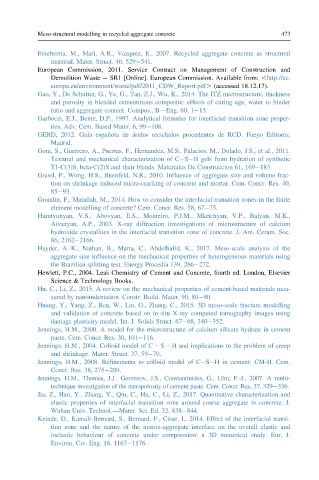Page 525 - New Trends in Eco efficient and Recycled Concrete
P. 525
Meso-structural modelling in recycled aggregate concrete 473
Etxeberria, M., Mari, A.R., Vazquez, E., 2007. Recycled aggregate concrete as structural
material. Mater. Struct. 40, 529 541.
European Commission, 2011. Service Contract on Management of Construction and
Demolition Waste SR1 [Online]. European Commission. Available from: ,http://ec.
europa.eu/environment/waste/pdf/2011_CDW_Report.pdf. (accessed 18.12.17).
Gao, Y., De Schutter, G., Ye, G., Tan, Z.J., Wu, K., 2014. The ITZ microstructure, thickness
and porosity in blended cementitious composite: effects of curing age, water to binder
ratio and aggregate content. Compos., B—Eng. 60, 1 13.
Garboczi, E.J., Bentz, D.P., 1997. Analytical formulas for interfacial transition zone proper-
ties. Adv. Cem. Based Mater. 6, 99 108.
GERD, 2012. Guı ´a espan ˜ola de a ´ridos reciclados procedentes de RCD. Fueyo Editores,
Madrid.
Goni, S., Guerrero, A., Puertas, F., Hernandez, M.S., Palacios, M., Dolado, J.S., et al., 2011.
Textural and mechanical characterization of C S H gels from hydration of synthetic
T1-C(3)S, beta-C(2)S and their blends. Materiales De Construccion 61, 169 183.
Grassl, P., Wong, H.S., Buenfeld, N.R., 2010. Influence of aggregate size and volume frac-
tion on shrinkage induced micro-cracking of concrete and mortar. Cem. Concr. Res. 40,
85 93.
Grondin, F., Matallah, M., 2014. How to consider the interfacial transition zones in the finite
element modelling of concrete? Cem. Concr. Res. 58, 67 75.
Harutyunyan, V.S., Abovyan, E.S., Monteiro, P.J.M., Mkrtchyan, V.P., Balyan, M.K.,
Aivazyan, A.P., 2003. X-ray diffraction investigations of microstructure of calcium
hydroxide crystallites in the interfacial transition zone of concrete. J. Am. Ceram. Soc.
86, 2162 2166.
Hayder, A.-K., Nathan, B., Marta, C., Abdelhafid, K., 2017. Meso-scale analysis of the
aggregate size influence on the mechanical properties of heterogeneous materials using
the Brazilian splitting test. Energy Procedia 139, 266 272.
Hewlett, P.C., 2004. Lea s Chemistry of Cement and Concrete, fourth ed. London, Elsevier
Science & Technology Books.
Hu, C., Li, Z., 2015. A review on the mechanical properties of cement-based materials mea-
sured by nanoindentation. Constr. Build. Mater. 90, 80 90.
Huang, Y., Yang, Z., Ren, W., Liu, G., Zhang, C., 2015. 3D meso-scale fracture modelling
and validation of concrete based on in-situ X-ray computed tomography images using
damage plasticity model. Int. J. Solids Struct. 67 68, 340 352.
Jennings, H.M., 2000. A model for the microstructure of calcium silicate hydrate in cement
paste. Cem. Concr. Res. 30, 101 116.
Jennings, H.M., 2004. Colloid model of C 2 S 2 H and implications to the problem of creep
and shrinkage. Mater. Struct. 37, 59 70.
Jennings, H.M., 2008. Refinements to colloid model of C S H in cement: CM-II. Cem.
Concr. Res. 38, 275 289.
Jennings, H.M., Thomas, J.J., Gevrenov, J.S., Constantinides, G., Ulm, F.-J., 2007. A multi-
technique investigation of the nanoporosity of cement paste. Cem. Concr. Res. 37, 329 336.
Jia, Z., Han, Y., Zhang, Y., Qiu, C., Hu, C., Li, Z., 2017. Quantitative characterization and
elastic properties of interfacial transition zone around coarse aggregate in concrete. J.
Wuhan Univ. Technol.—Mater. Sci. Ed. 32, 838 844.
Keinde, D., Kamali-Bernard, S., Bernard, F., Cisse, I., 2014. Effect of the interfacial transi-
tion zone and the nature of the matrix-aggregate interface on the overall elastic and
inelastic behaviour of concrete under compression: a 3D numerical study. Eur. J.
Environ. Civ. Eng. 18, 1167 1176.

